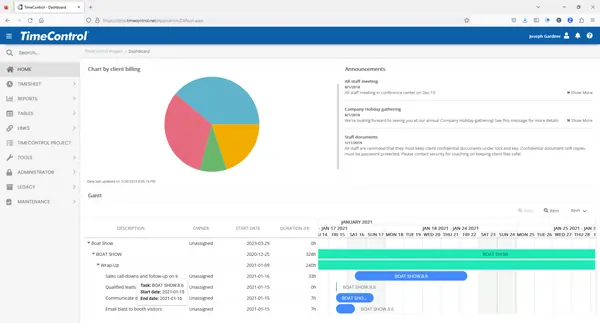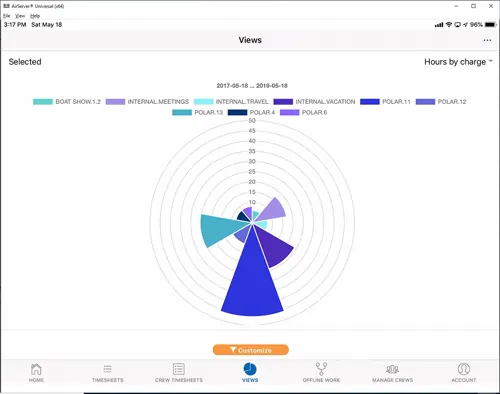TimeControl: A Strategic Timesheet Platform Aligning Project Execution with Financial Governance Across Complex Enterprise Environments
.webp)
Founded in 1984, HMS Software is the publisher of TimeControl, a versatile, multi-purpose timesheet system used worldwide. Originating as a project management consulting company, HMS developed TimeControl to meet the complex needs of finance and project management simultaneously, with a focus on auditability and flexibility. With over 40 years of expertise, TimeControl serves organizations of all sizes, offering both on-premise and cloud deployments. Their dedicated team combines software development, technical support, and implementation expertise to ensure smooth integration and client satisfaction. Specialized editions like TimeControl Industrial address high-volume field data collection and cost tracking needs.

In conversation with Mr. Chris Vandersluis, the Founder and President of TimeControl
Given the complex needs of modern businesses, TimeControl integrates with ERP and financial management systems. How flexible is the integration process, and what benefits does it offer to clients across different industries?
TimeControl was designed to be the centerpiece of integrating multiple business processes simultaneously, placing a premium on the flexibility of integration. It is delivered with numerous pre-built integrations for systems such as Oracle’s Primavera EPPM and Microsoft Project Online, as well as multiple functions for consuming and producing transactions between different systems. This includes the ability to automatically schedule data imports or exports between TimeControl and ERP or Finance systems through transaction files. Integration definitions are always driven by each client’s unique processes. In larger organizations, this can mean connecting with different financial systems for similar functions, such as disparate payroll systems across jurisdictions that all need to absorb hours from the same TimeControl system. TimeControl also includes a full-function bi-directional API for the most detailed integrations.
TimeControl offers advanced reporting and analytics features. How do you ensure that these insights are actionable for businesses, and how do you see data analytics evolving in your software offerings in the near future?
Having normalized, auditable data in the format TimeControl provides makes it a highly desirable source for business analytics. TimeControl includes numerous reporting mechanisms, such as a real-time dashboard, our standard Report Generator and Report Interface, the TimeControl Drill Down Analyzer for on-the-fly pivot table style analysis, and the TimeControl BI engine. Which analytics are appropriate and how they are transformed from display to action depends on each client. However, the availability of well-structured, task based, date organized data, validated to ensure completeness, makes TimeControl an ideal foundation for actionable insights.
TimeControl offers a comprehensive set of features for time tracking, project management, and compliance. What would you say is your product's most unique feature compared to competitors, and how has it contributed to customer satisfaction?
TimeControl’s most unique ability is fulfilling the needs of multiple business processes at the same time. Let’s face it, there are many timesheet systems on the market: payroll systems for time and attendance, project systems for task updates, billing systems for invoicing, and HR systems for tracking time off. But almost none can handle more than one of these perspectives simultaneously, leading many organizations to implement multiple timesheet systems.
No one enjoys ending their day by filling in a timesheet. Imagine doing two, three, or even four. We have had clients with up to nine distinct timesheet systems, all replaced by TimeControl as a single source of activity-based hours. That can result in significant savings and efficiency gains in countless ways.
What are the most common challenges that companies face when implementing TimeControl within their organizations, and how do you support them to ensure a smooth transition and high adoption rates?
Our prospective clients are often surprised by how much process they must address when deploying an enterprise timesheet system. Pre-deployment discussions often focus on features, but business processes are by far the more complex part. This is especially true for TimeControl, which is often chosen as a multi-purpose timesheet for several business processes at once. This means different departments must interact, sometimes for the first time. While the end result is always satisfying, the effort required to harmonize processes between departments often surprises those involved.
TimeControl has established itself as a leader in the time tracking and project management space. Looking ahead, how do you see the evolution of time management solutions in the next 3 to 5 years, especially with the growing trend of remote work and AI-powered productivity tools?
TimeControl has been in the market for over 30 years. We’ve seen many innovations during that time, including the proliferation of PCs, connected mobile devices, and the rise of the Internet. The latest trends of remote work and AI tools fit well with the TimeControl paradigm, as have those earlier changes. HMS and the TimeControl team always adapt to what is new. At its core, TimeControl is a fulfillment reporting interface—users need to commit to what they accomplished today or this week. End users don’t need analytics to do that. We often hear users wish AI would replace the timesheet and enter hours automatically. We ask if they would then be comfortable with AI deciding if they should be paid. The answer is always no. For many reasons, real people need to report what they actually did with their time. AI tools can help at the reporting and analytical level for managers and executives to extract value from that data.
With the increasing importance of data security and compliance, especially in industries such as finance and healthcare, how does TimeControl ensure the protection of sensitive time-tracking data and stay compliant with relevant laws and regulations?
Data security has been a priority since the very first version of TimeControl. After all, payroll information may come from TimeControl—what needs more security than that? We continuously ensure TimeControl’s processes and data remain government compliant and safe. We support both on-premise deployments and our TimeControl Online Software as a Service. We have SOC2 certification and comply with GDPR in Europe and UK GDPR in the UK. We conduct ongoing internal security reviews and publish our standards on our website.
In an era of automation and AI, are there any upcoming or experimental features in TimeControl that harness artificial intelligence or machine learning to improve time management or project efficiency?
We don’t comment on experimental or future features, but like every software publisher, we are exploring where AI could benefit our clients. This isn’t new—our company name, Heuristic Management Systems, reflects our early focus on what was then called machine learning in the 1980s. We believe AI functionality will be best applied to analytical features, so that is where our research and development for TimeControl is focused.
How does TimeControl measure the return on investment (ROI) for its clients? Are there any key success stories or metrics that demonstrate how businesses have achieved operational improvements or cost savings through your solutions?
We publish an ROI calculator on our website showing that TimeControl deployments can pay for themselves within weeks. The impact is even greater when replacing multiple existing timesheet systems. Each system consolidated into TimeControl eliminates associated effort and costs. Numerous case studies from clients like AMD, Azuria Water Solutions, OPAL-RT, Gunnison, and EXFO are available on our website at www.timecontrol.com/why-timecontrol/case-studies.
Chris Vandersluis| Short Bio
Chris Vandersluis is the President and Founder of HMS Software in Montreal and CEO and founder of EPM Guidance in Tampa. With over 40 years of experience in automating project management systems, he holds an economics degree from McGill University. He spent five years working with Microsoft on their Enterprise Project Management Partner Advisory Council and is a long-standing member of the Project Management Institute (PMI). Vandersluis has been published in major outlets like Fortune Magazine and the American Management Association’s Handbook of Project Management. He regularly contributes to Microsoft TechNet, Computing Canada, and PMI’s PMNetwork, and speaks at project management events worldwide.
“Whether you are starting your timesheet automation with TimeControl or you have already got automated timesheets, there are some good reasons to switch to TimeControl and some things to know about the migration.”
.webp)
.webp)































.webp)
